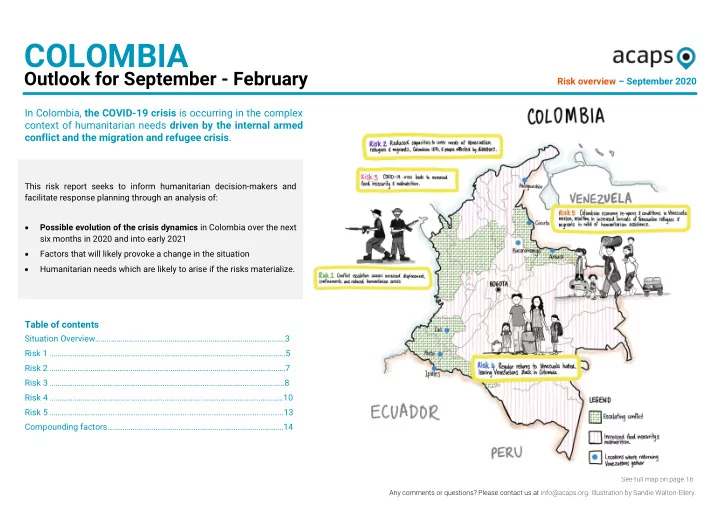

COLOMBIA Outlook for September - February Risk overview – September 2020 In Colombia, the COVID-19 crisis is occurring in the complex context of humanitarian needs driven by the internal armed conflict and the migration and refugee crisis . This risk report seeks to inform humanitarian decision-makers and facilitate response planning through an analysis of: • Possible evolution of the crisis dynamics in Colombia over the next six months in 2020 and into early 2021 • Factors that will likely provoke a change in the situation • Humanitarian needs which are likely to arise if the risks materialize. Table of contents Situation Overview……..……………………………………………………………………………….3 Risk 1 …………………………………………………………………………..……………………………….5 Risk 2 ……..…………………………………………………………………………………………………….7 Risk 3 ……………………………………………………………………………………………………………8 Risk 4 ……………………………………………………………………..……………………………………10 Risk 5 ……………………….................................................................................13 Compounding factors……….……………………………………………………………………….14 See full map on page 16 Any comments or questions? Please contact us at info@acaps.org. Illustration by Sandie Walton-Ellery.
ACAPS Risk Report Colombia Risk 1 Conflict escalation causes increased displacement, Risk 4 Venezuelan authorities halt regular returns to Venezuela, leaving confinements, and reduced humanitarian access Venezuelans with return intentions stuck in Colombia, unable to meet their basic needs The armed conflict has continued despite the COVID-19 crisis, with armed groups increasingly using national government measures to exercise social control over the The containment measures and COVID-19 outbreaks in countries throughout the region have triggered return movements of Venezuelan refugees and migrants to their home civilian population in areas where they are present. There is a risk of an escalation of the country. Currently the Venezuelan government allows only a small number of armed conflict, as armed groups take advantage of containment measures and the Venezuelans to return each week, via the official border crossings in Cúcuta and overstretching of the state security forces, to consolidate control over disputed areas. Arauca. Increased restrictions on border crossings, or even a complete halt to returns, This would likely lead to an increase in displacement, confinements, forced recruitments, and threats against social leaders. Fighting is likely to negatively impact risks overwhelming the capacities of Colombian border departments to meet the needs of those waiting to return, leading to an increase in people crossing irregularly. humanitarian access in the affected areas. Risk 5 Colombian economy re-opens and conditions in Venezuela Risk 2 Reduced capacities to cover humanitarian needs among worsen, resulting in increased arrivals of Venezuelan refugees and Venezuelan refugees and migrants, Colombian IDPs, and people affected migrants in need of humanitarian assistance by natural disasters As with most countries affected by humanitarian crises, funding shortfalls are likely in Although return movements from Colombia to Venezuela will likely continue over the Colombia in 2020 and 2021. The main donors, including the United States and coming months, an improvement of the situation in Colombia, particularly related to the European countries, have been significantly affected by COVID-19. Humanitarian economy and the lifting of restrictions on labour, paired with a worsening of the funding to Colombia is likely to reduce, which would lead to reduced capacities for a situation in Venezuela, is likely to trigger reverse movements and new arrivals of humanitarian response to people in need. Venezuelans in Colombia, with those arriving likely being increasingly vulnerable and in need of humanitarian assistance. Risk 3 COVID-19 crisis leads to increased food insecurity and malnutrition The national containment measures to reduce the transmission of COVID-19, including lockdowns and movement restrictions, are severely impacting livelihood opportunities, especially in the informal sector. Vulnerable people who have lost income are at risk of increased food insecurity and malnutrition, as household assets are depleted and households’ purchasing power is reduced. Price increases and supply chain disruptions are likely to further contribute to decreased access to food and dietary diversity. 2
Recommend
More recommend